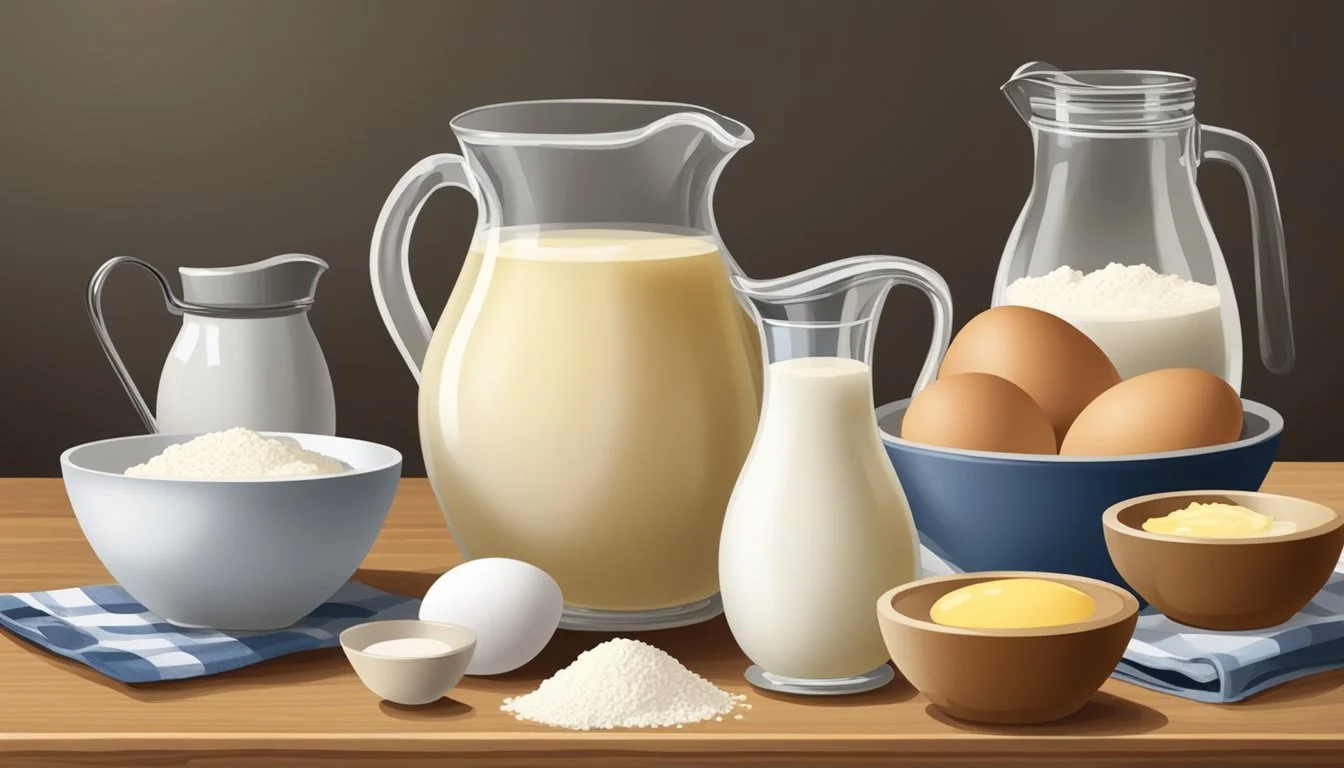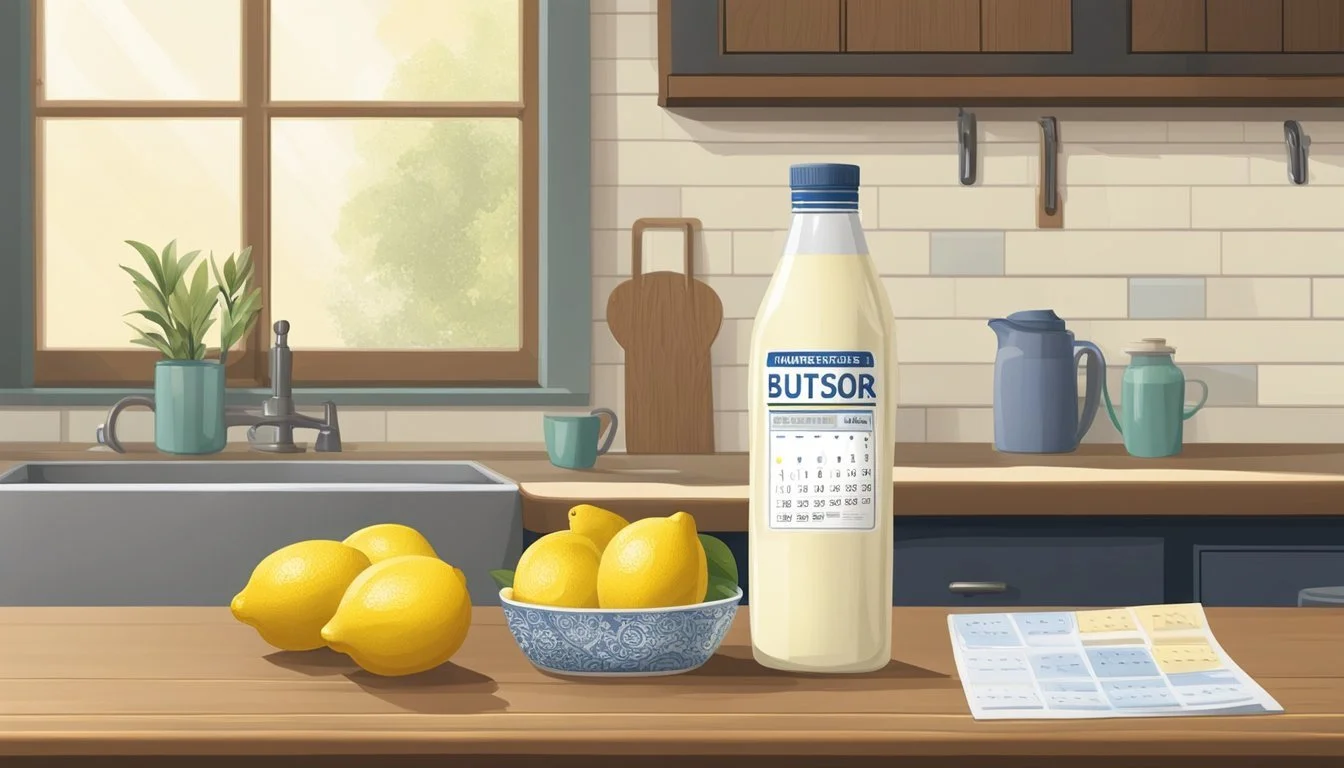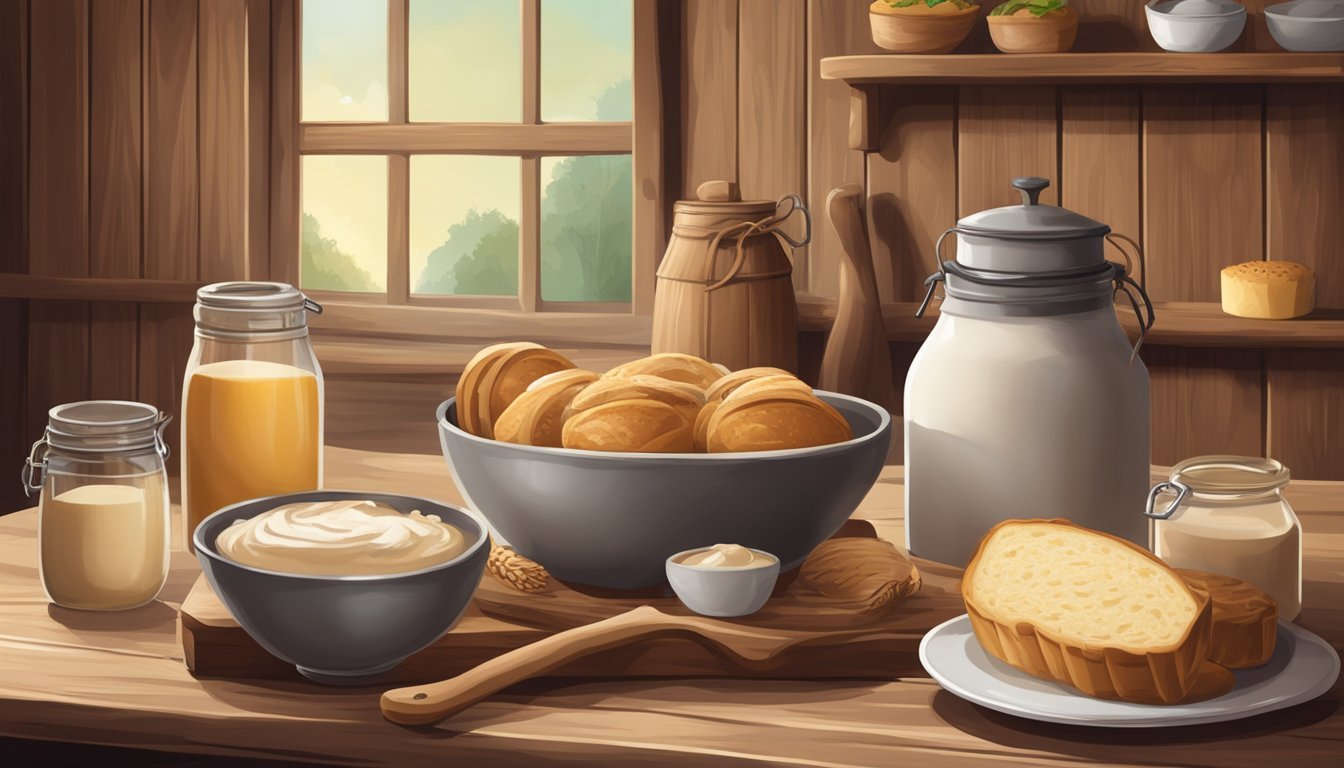Does Buttermilk Go Bad?
Understanding Shelf Life and Storage
Buttermilk, a beloved dairy product, is known for its tangy flavor and versatility in cooking and baking. But yes, buttermilk can go bad. Its shelf life varies depending on factors like storage conditions and packaging. Generally, buttermilk lasts about two weeks in the refrigerator after opening.
Identifying spoiled buttermilk is crucial for both safety and taste. Spoilage signs include off smells, thickened textures, and any mold growth. Freezing can extend its freshness for up to three months, though the texture may change upon thawing. Proper storage in airtight containers helps maintain its quality.
Understanding these details helps ensure that your culinary creations with buttermilk remain safe and delicious.
Understanding Buttermilk
Buttermilk, a dairy product known for its tangy taste and thick texture, is essential in various recipes ranging from baked goods to fried foods. This section explores its composition, usage in recipes, and compares commercially produced and homemade options.
Composition and Types
Buttermilk is categorized into two primary types: traditional buttermilk and cultured buttermilk. Traditional buttermilk is the liquid left behind after churning butter from cream and contains probiotics and lactic acid bacteria. This traditional method involves a natural fermentation process that imparts a slightly tart flavor and thicker consistency.
Cultured buttermilk, more commonly found in grocery stores, is made by adding lactic acid bacteria to regular milk. This results in similar acidity and texture to traditional buttermilk and can also contain probiotics. Both types of buttermilk are rich in lactic acid, which is key to their tanginess and culinary utility.
Buttermilk in Recipes
Buttermilk serves multiple functions in the kitchen. Its acidity makes it an excellent tenderizer, especially in marinades for fried chicken. It’s a common ingredient in baking as well, appearing in classic recipes for cakes, pancakes, and bread. The acidity reacts with baking soda, contributing to leavening and yielding a lighter, airy texture.
In recipes, buttermilk can often be substituted with a homemade mix of lemon juice or vinegar and regular milk. This provides a similar tanginess crucial for texture and taste in baked products. Additionally, it’s essential for achieving the signature softness in biscuits and muffins.
Commercial vs. Homemade
Commercially produced buttermilk is widely available and convenient. It adheres to consistent quality standards, ensuring a reliable ingredient for recipes. However, it may lack some of the nuanced flavors found in homemade buttermilk.
Making buttermilk at home is straightforward. Simply add 1 tablespoon of lemon juice or vinegar to 1 cup of milk and let it sit for about 10 minutes. This mixture initiates a simple fermentation process, producing a tangy substance similar to cultured buttermilk. The homemade method is advantageous for those preferring fresher ingredients or in settings where buttermilk is hard to find.
By understanding these aspects of buttermilk, cooks can better utilize this versatile ingredient in their culinary creations.
Shelf Life and Storage
Proper storage and recognizing spoilage indicators are essential for maintaining buttermilk's freshness. Knowing the criteria for expiration and optimal use periods ensures you consume buttermilk at its best quality.
Proper Storage Practices
Buttermilk should be stored in the refrigerator at or below 40°F (4.4°C). It is best to keep it in its original container, tightly sealed, to maintain its quality. If transferring to another container, ensure it’s airtight.
Avoid leaving buttermilk at room temperature for extended periods as warmer temperatures can accelerate spoilage. When returning it to the fridge, place the container in the coldest part, not the door, to preserve its freshness longer. Proper storage practices can extend the shelf life of opened buttermilk up to 14 days.
Recognizing Spoilage
Recognizing spoilage in buttermilk involves checking for visual and sensory changes. Spoiled buttermilk may show signs of mold growth, discoloration, or separation. If the liquid has developed a yellowish hue or shows visible clumps, it’s likely gone bad.
A sour smell more intense than the typical tangy buttermilk odor is another spoilage indicator. Always trust your senses. When in doubt, discard the buttermilk to avoid the risk of consuming spoiled dairy.
Expiration and Freshness
Typically, buttermilk remains fresh for 1-2 weeks beyond the expiration date printed on the label if unopened and stored correctly. Once opened, it should be used within a week to 14 days for optimal freshness.
Check the label for the expiration date as a guideline, but not an absolute limit. Using it promptly after opening and following proper refrigeration techniques ensures the best quality. By adhering to these practices, you can enjoy buttermilk at its peak flavor and safety.
Signs of Buttermilk Going Bad
Identifying spoiled buttermilk is crucial for health and culinary purposes. Recognizable signs include changes in consistency, alterations in taste and smell, and visual indicators like mold or discoloration.
Changes in Consistency
Buttermilk's consistency is a key indicator of freshness. Fresh buttermilk should be smooth and slightly thick but still pourable. Bad buttermilk, on the other hand, often becomes excessively thick, chunky, or slimy.
Noticeable changes in texture:
If it pours out in large lumps or looks curdled.
Separation of liquids into distinct layers, resembling curd and whey.
These signs often indicate the buttermilk has spoiled and should not be consumed.
Alterations in Taste and Smell
Taste and smell provide additional clues about the freshness of buttermilk. Fresh buttermilk has a tangy flavor, but it should still be pleasant.
Smell:
A strong, unpleasant sour smell suggests spoilage.
If the tanginess smells off or rancid, the buttermilk has likely gone bad.
Flavor:
Sour cream or off-tasting buttermilk is a sign it is no longer good.
These sensory changes suggest the buttermilk has deteriorated and is no longer safe for use.
Visual Indicators of Spoilage
Visual inspection can also help in determining if buttermilk is spoiled. Look for signs of mold and discoloration.
Mold:
Presence of mold on the lid or floating on the surface.
Color:
Fresh buttermilk is usually white or pale yellow. Any significant discoloration, such as yellowing or a grayish hue, indicates spoilage.
These visual clues are critical in identifying bad buttermilk quickly and effectively.
Preservation Techniques
To extend the shelf life of buttermilk, there are several effective methods. Freezing, proper thawing, and alternative preservation options can ensure it lasts longer without losing its quality.
Freezing Buttermilk
Freezing buttermilk is a straightforward way to preserve it. Pour the buttermilk into an airtight container or use an ice cube tray for portion control. Leave some space at the top of the container to account for expansion. Label the container with the date to keep track of storage time. Buttermilk can remain frozen for up to 3 months without significant quality loss.
Thawing and Using Frozen Buttermilk
When ready to use, transfer the frozen buttermilk from the freezer to the refrigerator. Allow it to thaw gradually over several hours to maintain its smooth consistency. Once thawed, give it a good stir as separation can occur. Thawed buttermilk is best used in recipes that involve cooking or baking, as its texture might slightly change compared to fresh buttermilk.
Alternative Preservation Methods
Powdered buttermilk is an excellent alternative for long-term storage. In its original resealable packaging, it can last up to two years, and when transferred to an airtight container, it can last for up to ten years. This method is particularly useful for those who use small amounts intermittently. Keeping buttermilk in a consistently cold environment and minimizing exposure to air are key to maintaining its quality.
Safety and Health Considerations
When addressing the consumption of buttermilk, it is crucial to evaluate safety aspects such as foodborne illness risks, and the nutritional benefits that buttermilk offers.
Foodborne Illness and Buttermilk
The safety of buttermilk is paramount. Harmful bacteria such as E. coli and Salmonella can pose significant health risks if buttermilk is improperly stored. Fresh buttermilk should exhibit a smooth and slightly thick texture. If it becomes excessively thick, chunky, or slimy, it indicates spoilage, rendering it unsafe for consumption.
Raw buttermilk is at a higher risk of contamination compared to pasteurized buttermilk. Homemade buttermilk, often made by adding an acidic agent to milk, should be stored with stringent hygiene practices to prevent food poisoning. Storing buttermilk in the refrigerator and ensuring it is kept in sealed containers can significantly reduce the risk of contamination. Additionally, keeping buttermilk frozen at temperatures below 0°F (-18°C) can extend its shelf life without compromising its quality. Thawing should be executed in the refrigerator to ensure safety.
Nutritional Value
Buttermilk boasts an impressive nutritional profile, offering several health benefits. It contains higher protein levels compared to regular milk, which is essential for muscle repair and growth. Additionally, buttermilk is rich in probiotics, beneficial bacteria that promote gut health and aid in digestion.
Its nutritional content includes essential vitamins and minerals such as calcium, potassium, and vitamin B12. These contribute to bone health, proper muscle function, and overall well-being. Pasteurized buttermilk retains most of these nutritional benefits and poses less risk of foodborne illness. However, consumers should be mindful of its sodium content if they are monitoring their salt intake.
Culinary Applications of Buttermilk
Buttermilk enhances both the flavor and texture of numerous culinary dishes. Its tangy flavor and versatility make it a frequent choice in baking, cooking, and for creating various buttermilk-based products.
Buttermilk in Baking
Buttermilk is a prized ingredient in baking due to its acidic nature, which reacts with leavening agents like baking soda to produce a light, airy texture. It's commonly used in cakes, breads, and biscuits. Recipes such as buttermilk pancakes and muffins benefit significantly from its tangy flavor and moisture-enhancing properties.
When a recipe calls for buttermilk and none is available, a popular substitute is a mixture of milk and vinegar or lemon juice. For a cup of buttermilk substitute, mix one tablespoon of vinegar or lemon juice with enough milk to make one cup, and let it sit for 5-10 minutes.
Cooking with Buttermilk
Buttermilk is frequently used in cooking to marinate meats, especially chicken. The acidity helps tenderize the meat while infusing it with a subtle tangy flavor. Marinating chicken in buttermilk before frying gives it a moist and tender texture, making it a key component in many fried chicken recipes.
Additionally, buttermilk is used to create creamy dressings and dips. It mixes well with herbs and spices to make delicious ranch dressings or coleslaw dressings. Its use in these applications adds a rich, tangy dimension to the final dish.
Buttermilk-Based Products
Buttermilk is not just used on its own but also as a base for other products. Cultured buttermilk is thicker and more flavorful due to additional fermentation. This type is often used in cheese and yogurt production.
It can also be consumed as a beverage, either plain or flavored. Its rich flavor and probiotic benefits make it a popular choice in many cultures. Buttermilk-based products provide the same tangy flavor and versatile use, making them valuable in various culinary contexts.
Exploring Buttermilk Substitutes
When buttermilk isn't available, various alternatives can mimic its taste and acidity. These substitutes use common ingredients and offer both dairy and non-dairy options to fit different dietary preferences.
Homemade Alternatives
Milk with Lemon Juice or Vinegar: Combine 1 tablespoon of lemon juice or vinegar with 1 cup of milk. This mixture needs to sit for about 10 minutes to curdle, providing the acidity and tang of buttermilk. This works well in most baking recipes, though it may not have the same thickness.
Milk and Cream of Tartar: Mix 1 cup of milk with 1 ¾ teaspoons of cream of tartar. This option provides the necessary acidity but may result in a slightly different consistency.
Yogurt or Sour Cream: Use equal parts natural yogurt or sour cream thinned with water or milk to reach a pourable state. These alternatives offer a similar tangy flavor and work well in recipes requiring a thicker consistency.
Dairy and Non-Dairy Options
Kefir: A cultured dairy product similar to buttermilk, kefir can be used directly as a substitute. Its tangy taste and thick texture make it ideal for baking. Sometimes, thinning with a bit of milk is necessary.
Buttermilk Powder: This option involves mixing powder with water according to package instructions. It's convenient for storage and provides the tangy flavor required in recipes.
Non-Dairy Milk with Acid: For a non-dairy alternative, mix 1 cup of plant-based milk (such as soy or almond milk) with 1 tablespoon of lemon juice or vinegar. This combination creates a usable buttermilk substitute that maintains the necessary acidity and consistency.
These substitutes ensure that the flavor and texture of recipes are preserved even when traditional buttermilk is unavailable.
The Cultural Significance of Buttermilk
Buttermilk holds an important place in various cultural contexts, reflecting unique traditions and culinary practices. Its role varies significantly across different regions, showcasing its versatility and deep-rooted significance.
Buttermilk in the United States
In the United States, buttermilk has been a staple in southern cuisine for generations. It is often used in baking to create light and fluffy biscuits, as well as in fried chicken marinades for its tenderizing properties. Traditional buttermilk was the liquid left after churning butter, while cultured buttermilk available today is fermented milk made with lactic acid bacteria, giving it a tangy flavor.
Historically, buttermilk was valued not only for its culinary uses but also for its health benefits, believed to aid digestion. It was a common beverage in rural areas, offering a nutritious and refreshing drink during warm months. Its slightly acidic nature creates a favorable environment for beneficial bacteria, contributing to gut health.
The Role of Buttermilk Globally
Globally, buttermilk enjoys a rich cultural tapestry. In Eastern European societies, buttermilk is deeply entwined with pastoral traditions, where it is consumed regularly, symbolizing simplicity and communal values. In Denmark, buttermilk features prominently in traditional recipes, including desserts like koldskål, a chilled buttermilk soup served with biscuits.
In Indian cuisine, buttermilk, or chaas, is a popular beverage flavored with spices and used to cool the body in hot climates. It is also used in various dishes to add a tangy taste and aid digestion. Diacetyl, a compound responsible for its buttery flavor, enhances the taste of many traditional recipes.
Buttermilk's pluralistic presence across cultures highlights its adaptability and enduring culinary significance. Whether through its use in everyday meals or special dishes, buttermilk continues to be cherished around the world.







